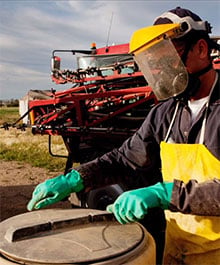Chemicals are a fact of life in agriculture. We use them everywhere for almost everything. So it’s important to know the best practices for handling them carefully, storing them safely, and what to do in the event of unexpected exposure.
 Liquid Chemicals
Liquid Chemicals
Farmers spend a lot of time each year treating their fields and crops with chemicals, like fertilizers and pesticides.
- Substitute a less hazardous material, if possible.
- Have good ventilation when working with hazardous materials.
- Store liquid chemicals in their proper containers and make sure they are clearly labeled.
- Corrosives should be stored in a separate area away from other liquid chemicals.
- Follow the Safety Data Sheets (SDS) guidelines for handling any dangerous farm chemicals, including disposal afterward.
- Always wear the proper personal protective equipment.
Seed Treatments
Most of the seed planted every year is treated with pesticide. This type of seed should be handled with care to prevent exposure to the handler, wildlife, and water supplies.
- Treated seed should never be used for food or feed.
- Any treated seed left on the surface of the soil should be collected to prevent poisoning the wildlife.
- Store treated seed away from other feed and foodstuffs.
- Follow the seed bag labels’ instructions for planting and handling.
- Again, be sure to wear the proper personal protective equipment.
Knowledge: Your Best Weapon in an Emergency
Being familiar with the information in the SDS for any chemical or seed is your first line of defense in handling dangerous chemicals. But if a leak, spill, or fire does occur, it’s just as important to know what to do.
- Evacuate the area at once, especially if you can’t control the situation or don’t know what to do.
- Alert others to the emergency.
- Call emergency personnel, such as the fire department and EMTs.
- Report the problem to your organization’s safety director.
- Obtain or initiate first aid.


